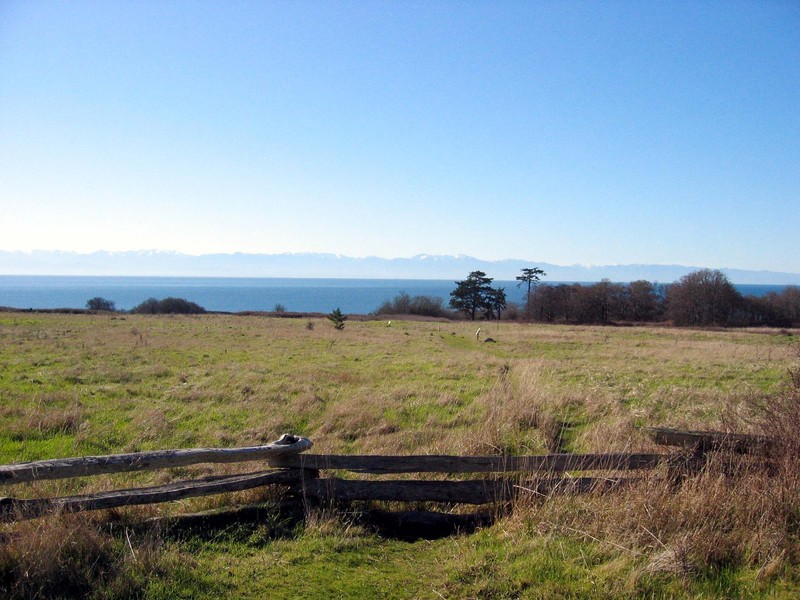San Juan Island National Historical Park
Introduction
Text-to-speech Audio
Images
The view of the Puget Sound from the Belle Vue Sheep Ranch site. It was here that "Pig War" began in 1859.

The British camp features this formal garden as well as historic structures including barracks and a blockhouse.

Backstory and Context
Text-to-speech Audio
Spanish, British, and Russian explorers first arrived in the Pacific Northwest—present day Oregon, Washington, Idaho, and parts of British Columbia, Montana, and Wyoming—in the late 1700s and laid claim to the region (the United States did as well). They were attracted to the region's temperate climate, abundant natural resources, and land perfect for growing crops (Native Americans had been taking advantage of these resources for thousands of years). Unsurprisingly, these claims often overlapped and the maps that were available at the time were not always accurate.
In the early 1800s, Russia and Spain had given up their claims, leaving the United States and Britain to vie for control. The two countries agreed to control the territory together, for the time being, under the 1818 Treaty of Joint Occupation of Oregon (the region was called Oregon Country). During the next several decades, the region remained mostly inhabited by Native peoples, who had lived there for thousands of years. The Hudson Bay Company was very active but was solely interested in fur trading and maintaining the peace with the tribes. American settlers started to move into the territory in the 1830s and 1840s but their numbers were few. Some American politicians, however, demanded that Britain give up their claim to Oregon Country entirely. For their part, the British contended that the territory was theirs because of treaties signed with Russia and Spain.
The next development came in 1846 when the U.S. and Britain signed the Treaty of Oregon, which established the border between the U.S. and present-day Canada at the 49th parallel. It also granted Vancouver Island to the British. The treaty did not, however, resolve ownership of the San Juan Islands because the two sides couldn't agree on where the boundary between Vancouver Island and Oregon would be. Nonetheless, neither country tried to occupy the islands in the immediate years that followed and the issue remained unsettled.
Eventually, this situation began to change. The Hudson Bay Company established a salmon station on San Juan Island in 1851. Two years later, it established the sheep ranch farm, called Belle Vue and operated by Charles Griffin, on the southern tip of the island. Word of the ranch spread quickly and local American officials confronted the British on a number of occasions demanding that the British pay custom duties. Then in 1858, American settlers, including Lyman Cutlar, started to arrive on the island, which angered the British.
It was in this context that that "Pig War" began. Cutlar established a farm near Griffin's sheep ranch in April 1859. Soon after, one of Griffin's pigs started to forage in Cutlar's potato patch. The pig returned a couple more times before finally Cutlar had enough on June 15th when he shot it. Cutlar agreed to pay Griffin for the pig but Griffin wanted much more. Cutlar refused to pay the additional amount and the British threatened to arrest him and also force all of the other settlers off the island.
In response, an American force, led by George E. Pickett, who would later become famous as a Confederate general during the Civil War, arrived near the farm on July 27. The British sent a small fleet of warships to dislodge Pickett and his men but its commander decided not to engage the Americans. Upon learning of the situation, both countries called for calm, not wanting start a war over a pig. But for the next twelve years, the situation remained at a stalemate. During that time, the British and Americans lived together peacefully.
The Treaty of Washington was finally signed in 1871 but it did not specifically resolve the ownership of San Juan Island. In fact, it called for negotiation of the issue and Kaiser Wilhelm I of Germany was asked to do arbitrate. He established a three-man commission who, in the end, ruled in favor of the United States. As a result, San Juan Island officially became American territory.
Sources
Huffman, Laurin C. "San Juan Island National Historical Park - English Camp." National Park Service - National Register of Historic Places Nomination Form. October 15, 1966. https://npgallery.nps.gov/GetAsset/3322f666-0a27-4698-9580-8a2d68d7b102.
Oldham, Kit. "San Juan Island Pig War - Part 1." HistoryLink.org. September 15, 2004. https://www.historylink.org/File/5724.
Oldham, Kit. "San Juan Island Pig War - Part 2." HistoryLink.org. September 15, 2004. https://www.historylink.org/File/5725
"The Pig War." National Park Service. Last Updated 4, 2016. Accessed February 20, 2020. https://www.nps.gov/sajh/learn/historyculture/the-pig-war.htm.
National Park Service
Chris Wright, via Wikimedia Commons: https://commons.wikimedia.org/wiki/File:San_Juan_Island_NHP_Eng_Camp.JPG
